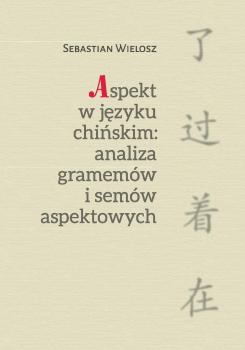Aspekt w języku chińskim: Analiza gramemów i semów aspektowych
Keywords:
aspect, grammatical aspect, lexical aspect, Mandarin Chinese, aspectual grammeme, aspectual seme, componential analysis, aspectual semanticsSynopsis
ASPECT IN MANDARIN CHINESE: ANALYSIS OF ASPECTUAL GRAMMEMES AND SEMES
The category of aspect in the history of linguistic research has been the subject of many considerations and studies. The approach to its functioning and scope has undergone a lot of changes. Originally regarded as a subcategory of tense, it is nowadays commonly seen as a separate category, albeit one that contributes to the temporal system of language. The earliest aspectologists only dealt with languages of the Indo-European family in their research – first Slavic and later Germanic. In these languages, it is related to the morphology of the verb and for this reason it was common to consider aspect as a grammatical or primarily grammatical category. The topic of aspect in relation to Indo-European languages has seen numerous publications. Less attention has been paid to the precise description of this category in Mandarin Chinese, although there are numerous publications dealing with the subject. Initially, scholars associated aspect with deictic tense, and it was not until the 1940s that the differences between the two began to be recognised and the semantics of aspect were addressed, although the work emerging at that time can hardly be considered of value. It is only the research of Smith (1991) that is considered the first significant turn of sinological aspectology in this direction, and it remains an inspiration for aspectologists conducting research on Mandarin Chinese to this day. The lack of greater attention paid to aspect by linguists at this stage may be due to typological issues. This is because the Chinese language is analytic, with a tendency towards agglutination. Instead, the languages under study are mainly inflectional languages, in which both the category of aspect and tense are embedded in the morphology of the verb.
Chapters
-
TABLE OF CONTENTS
-
1. Wprowadzenie .......... 15
-
1.1. Cele i założenia badań .......... 15
-
1.2. System temporalny współczesnego języka chińskiego – uwagi wstępne .......... 17
-
2. Kategoria aspektu w języku naturalnym – charakterystyka .......... 23
-
2.1. Aspekt – synteza najważniejszych informacji i próba definicji .......... 23
-
2.2. Temporalne kategorie czasu i aspektu .......... 31
-
3. Aspekt w ujęciu gramatycznym i semantycznym .......... 39
-
3.1. Gramemy i semy aspektowe .......... 40
-
3.2. Problem opozycji aspektowych .......... 50
-
4. Aspekt leksykalny i semantyczne klasy predykatywów .......... 57
-
4.1. Aspekt leksykalny: źródło terminu i jego zakres .......... 57
-
4.2. Semantyczne klasy czasowników Vendlera i propozycje innych badaczy .......... 66
-
4.3. Kryteria stanowości i zmiany jako pojęcia proste w semantyce aspektu leksykalnego .......... 73
-
4.4. Semantyczne klasy predykatów aspektualnie prostych i złożonych .......... 79
-
5. Metodologia badań nad aspektem języka chińskiego .......... 89
-
6. System temporalny języka chińskiego .......... 95
-
6.1. Kategoria czasu w języku chińskim .......... 95
-
6.2. Miejsce aspektu w systemie temporalnym języka chińskiego .......... 107
-
6.3. Aspekt jako kategoria pomocnicza w referowaniu temporalnym .......... 113
-
7. Gramemy aspektowe w języku chińskim .......... 123
-
7.1. Gramem 了 le .......... 123
-
7.2. Gramem 过 guo .......... 131
-
7.3. Gramem 着 zhe .......... 140
-
7.4. Gramem 在 zài .......... 151
-
8. Semy aspektowe w semantemach w języku chińskim .......... 159
-
8.1. Semantemy proste .......... 159
-
8.2. Semantemy złożone .......... 171
-
9. Współwystępowanie nośników aspektowych .......... 189
-
9.1. Współwystępowanie semantemów prostych i gramemów aspektowych .......... 189
-
9.2. Semantemy złożone i ich współwystępowanie z gramemami .......... 202





